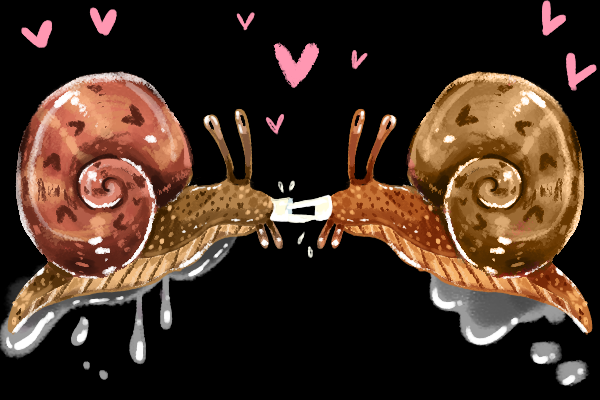Ah nature! Dunedin is blessed with many romantic public parks, reserves, and gardens. Filled with the birds and the bees, the flowers and the trees – there is literally love all around us. With Valentine’s Day approaching, why not take a picnic and ponder some romantic strategies used by the lovely leaf litter dwellers.
Struck by cupids arrow
The garden snail Cornu aspersum carries a love dart, but in reality, it is not as romantic as you might think. It is a hard structure (technically called the gypsobelum) is made of aragonite a crystalised form of calcium carbonate. [1] The snails use the dart to stab each other prior to copulation. It doesn’t fly through the air, but shoots out more like a harpoon and remains temporally lodged in the recipient. Garden snails are hermaphrodites and both snails participate in mutual dart stabbing. The love dart is not involved in sperm delivery but does aids paternal success. It delivers a hormone-laced mucus cocktail that helps ready the recipient snail’s female reproductive system, so the donated sperm is stored rather than rejected by the snail’s female functions. [2] [3]
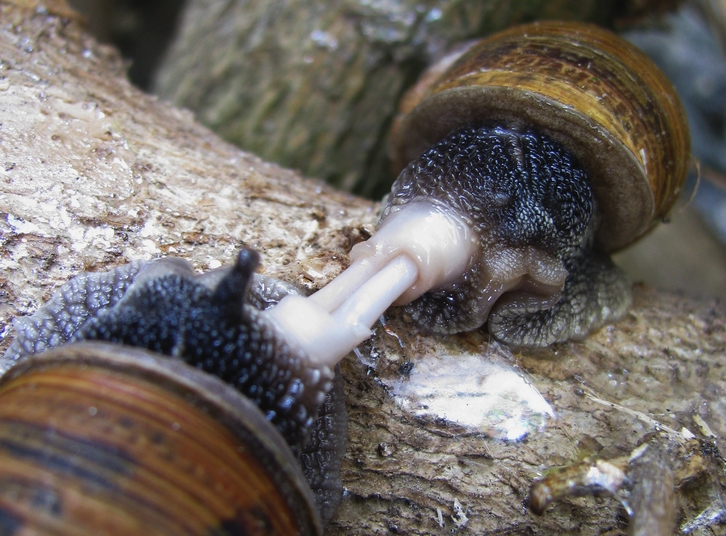
Two garden snails jousting love darts, Carla Isabel Ribeiro © Wikicommons CC BY-SA 3.0
Exchanging gifts
Leaf-vein slugs are all about the gift exchange. Up to 10 cm long, these juicy jubes are hermaphrodites that smoothly saunter around looking for equally generous like-minded slugs to exchange special parcels – of sperm. They exchange gifts through genital cavities in their head called gonophores. Rather than self-fertilisation, these singles are ready to mingle. Late on warm dark damp nights in summer, you can sometimes find them congregating in gardens around Dunedin. We have had observations reported in Dunedin from Ōpoho and West Harbour in the past.
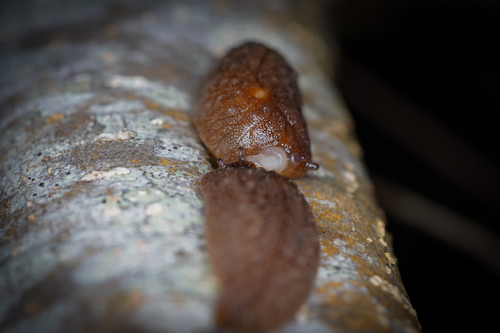
Leaf-vein slugs enjoy an evening out canoodling and exchanging gifts. Andrew Simpson © iNaturalistNZ CC BY 4.0
Aerial acrobatics
Also hermaphrodites, leopard slugs tend to fertilise their own eggs. Sexual encounters are rare; and may only happen once in a slug’s life, possibly because leopard slugs make it such a kinky event. In the dark of night, an amorous slug follows the slime trail left in the wake of their bae, who leads them to an overhang. Popular romantic locations include the underside of branches or leafy fronds.
They coil tightly together in an intricate embrace; dangling, suspended from a thick glistening thread of mucus, up to half a metre long. [4] They unfurl and entwine their translucent bluish genitalia. The mutual exchange of sperm is external to their bodies, and the whole encounter takes place over several hours in the darkness. [5]
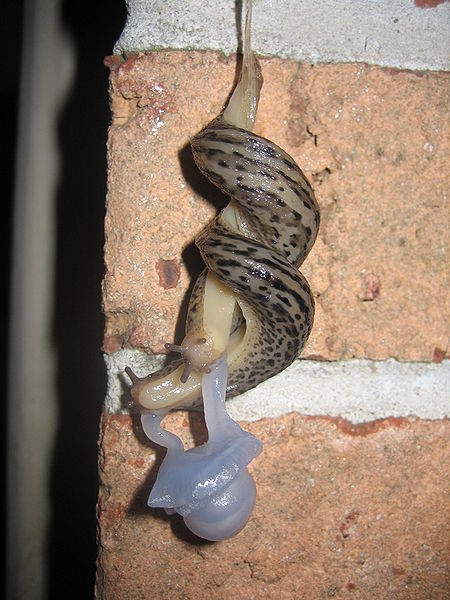
Slugs sporting leopard skins participating in their sexy aerial antics, © Spleines, Wikicommons CC BY- SA 3.0
Consent to approach
In many spider species, males need to be very careful and clear about their intentions as they
approach females. She is generally larger, and she is generally hungry. To avoid a fatal
misunderstanding, male spiders employ different species-specific strategies such as visual displays, vibrations, or pheromones to signal his attraction to a female from a safe distance. If she is interested in his proposal, she will allow the Romeo to approach. It does not always go well for him though, he could be eaten, or even if copulation occurs, some female spiders can expel sperm after mating if they choose.
.jpg)
Mate or meal? A small male (left) vagrant spider fails to convince a large female (right) and ends up as dinner © Steve Kerr, iNaturalistNZ, CC-BY 4.0
Quick hook ups
Unlike other arachnids though, male and female harvestmen do not know they have encountered one another until physical contact is established. It tends to involve a brief face-to-face, males generally grasp the female in their pedipalps and produce a nuptial gift – a glandular secretion for the female to feed on before mating. In some species, once mated, the couple flee from one other, while in other cases males protectively lurk, waiting for females to lay her eggs in a bark crevice or a similar safe spot. Their association generally ends when the female leaves his territory. [6]
.jpg)
Harvestmen waiting for a harvestlady Kane Fleury © iNaturalistNZ, CC BY 4.0
Dance and folly
When two silverfish meet, there is dancing. They wave and tremble the tips of their antenna at each other until they touch, and then back away and repeat. Eventually, the male dashes away, while the female gives chase. He suddenly stops and they begin their antenna trembling again. After about 30 minutes of this foreplay, the male will position himself beside the female and produce a fine silk-wrapped package called a spermatophore, which he places on the ground for her. The female walks over and sits on his gift, drawing it into her body and fertiliszing her eggs. [4]
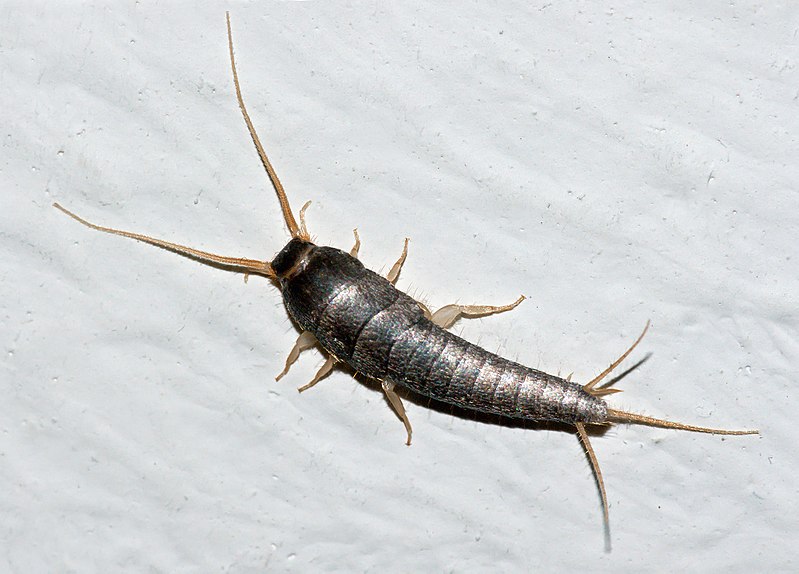
Solo silverfish, Lepisma saccharina, seeks dance partner. Christian Fischer © Wikicommons CC-BY 3.0
Enjoy a nice meal out
Checking out the latest hip spot to eat and hang out is the perfect romantic tactic for many flies from the family Calliphoridae. They are big into organic and fermenting foods. Animal carcasses, feces, rotting plant matter, mould, and fungus all create a buzz, attracting crowds of flies looking for a like-minded lover keen to brood a family of little maggots.
_Sep._2015.jpg)
A hip hangout for a group of hairy maggot blow flies, Chrysomya rufifacies © Bill Waller, Wikicommons, CC BY-SA 3.0
Festivals of love
Native grass grubs live in the top 15 cm of soil, gobbling and gnawing on grass, clover, seedlings, and crop roots. In early spring, the larvae pupate, which is their transition from grub to adult beetle.
Once in their adult form, they remain in the soil dormant for about a month, waiting for a mysterious signal. Then suddenly, just after sunset during spring to late summer evenings, they stir to life. They emerge from the ground and, in peak seasons, can form a synchronised swarm of thousands of hedonistic beetles on their mating flight. They are seen buzzing and bumping under porch and streetlights. [4] After the epic mating flight, they can form a hungry hoard, swarm feeding on young leaves of a wide range of shrubs and trees. [7] They cause major headaches for orchardists and market gardeners.
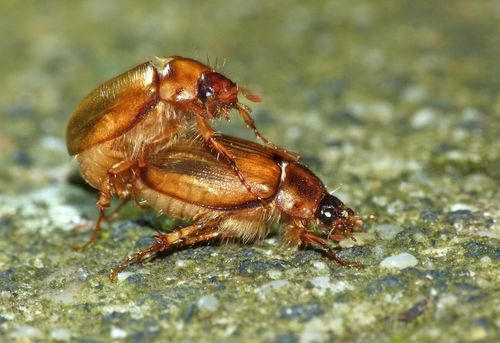
Grass grub beetles, Costelytra zealandica, lovers caught in the act, ©Steve Kerr, iNaturalist CC BY 4.0
References:
1 – Kimura, K. Chiba, S. Koene, J.M. (2014) Common effect of the mucus transferred during mating in two dart-shooting snail species from different families. Journal of Experimental Biology 2014 217: 1150-1153 DOI: 10.1242/jeb.095935
2- Lodi, M. and Koene, J.M. (2016). The love-darts of land snails: integrating physiology, morphology and behaviour. Journal of Mollusc Studies. 82:1-10.
3 - Lodi, M. and Koene, J.M. 2017. Hidden female physiological resistance to male accessory gland substances in a simultaneous hermaphrodite. Journal of Experimental Biology 2017 220: 1026-1031; DOI: 10.1242/jeb.149963
4 – Lindsey, T. and Morris, R. (2014) Collins Pocket Guide to New Zealand Minibeasts, Harper Collins Publishers.
5 - Douglas, M, (2015) The strange and sensational world of leopard slug sex, Life through the lens, BCC Earth. http://www.bbc.com/earth/story/20150114-the-strange-sensational-world-of-leopard-slug-sex
6 - G. Machado, Requena, G.S, Gadea, C.T, Stanley, E. Macías-Ordóñez, R. (2015) Male and Female Mate Choice in Harvestmen: General Patterns and Inferences on the Underlying Processes ‘in’ A.V. Peretti and A. Aisenberg (eds.), Cryptic Female Choice in Arthropods, Patterns, mechanisms and prospects Springer International Publishing Switzerland 2015, pp 169 – 201 DOI: 10.1007/978-3-319- 17894-3_7
7 – Helson, G.A (1974) Insect Pests, Ministry of Agriculture and Fisheries New Zealand Bulletin 413


